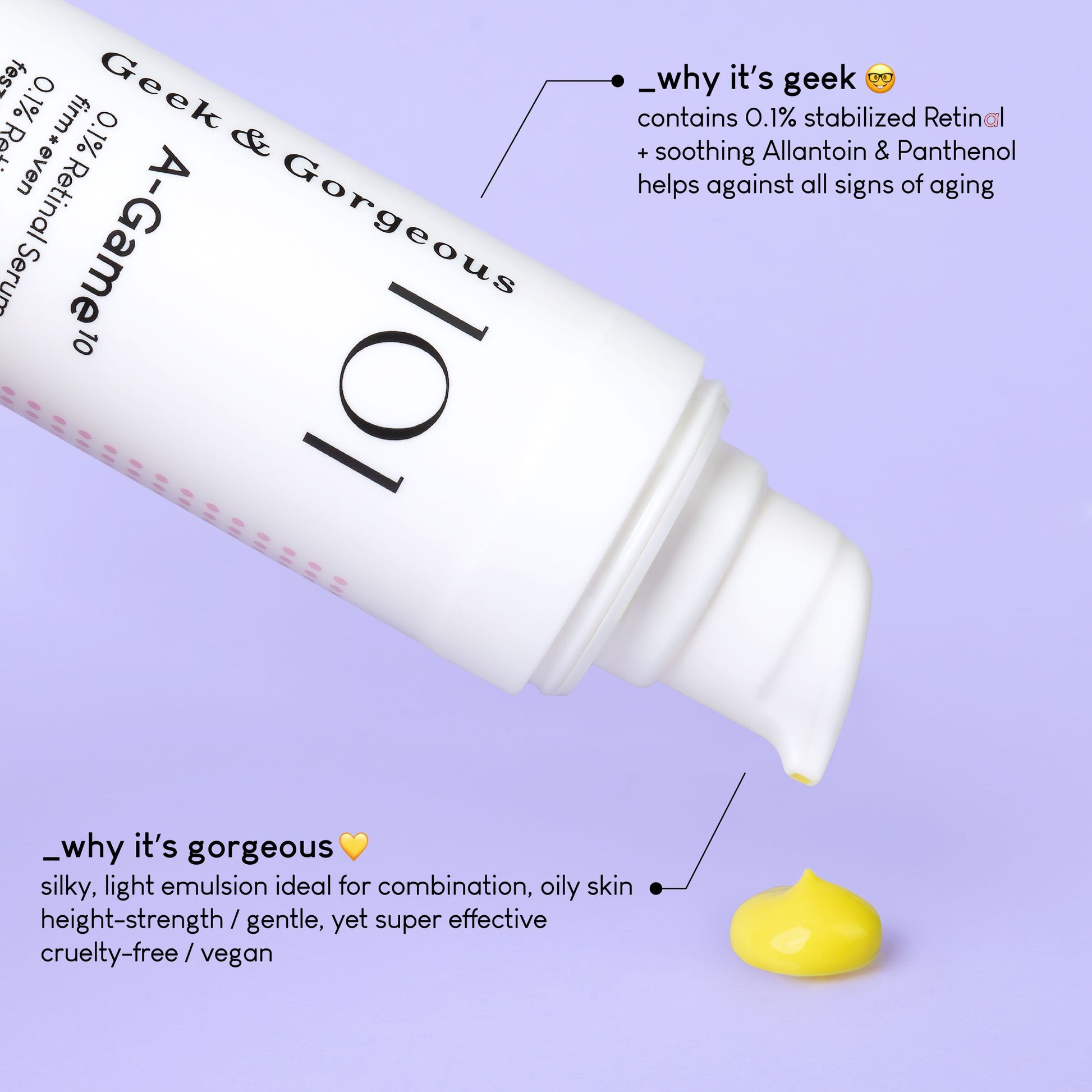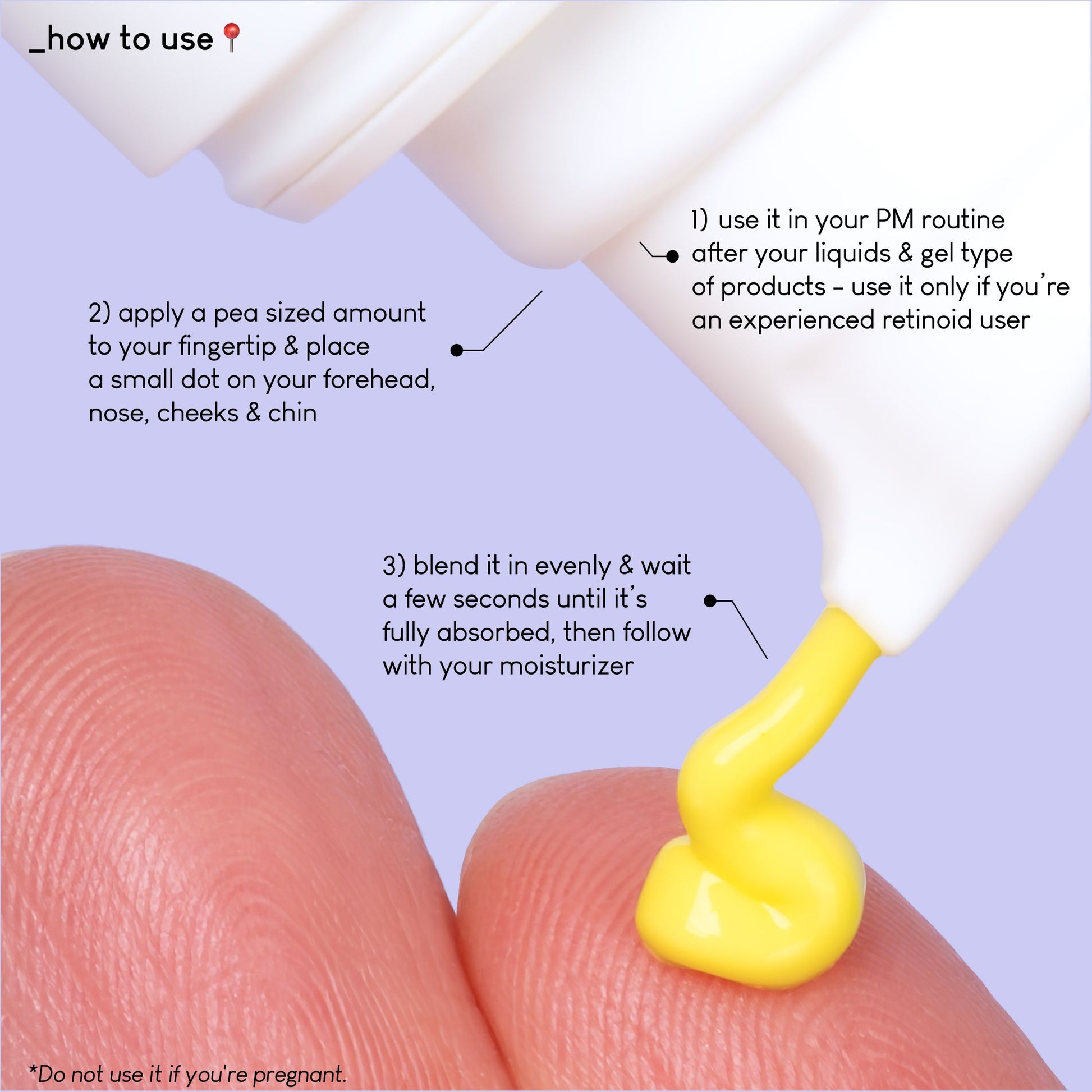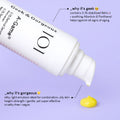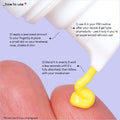A-Game 10
New airless bottle, same formula as before :)
A silky, light emulsion containing a high-strength amount of retinal to help against all signs of aging.
30 ml
Skin type: all skin types
Skin concern: lines & wrinkles, loss of firmness, uneven skin, pigmentation, dullness, lack of radiance
Cruelty-free | Vegan | Breastfeeding-safe | Fragrance & Essential oil free | Gluten-free
Good to know: This product is for experienced retinoid users. If you are just starting out, we recommend A-Game 5, our mid-strength Retinal serum.
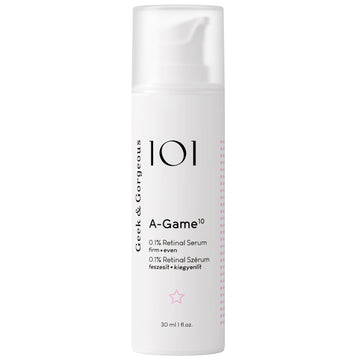
A-Game 10
description
Retinal is the "big brother" molecule of the better known anti-aging superstar, Retinol. While Retinol needs two metabolic conversion steps to reach the active form, Retinoic Acid (aka Tretinoin), Retinal is the direct precursor only one conversion step away from the active form the skin cells understand. It is estimated that Retinal can convert more than 10x faster to Retinoic Acid than Retinol, making Retinal an outstandingly effective member of the retinoid family (Vitamin A family).
- 6-6.5 pH
- 0.1% Retinal
- + Allantoin Biosaccharide Gum-1
Once converted, Retinal helps the skin cells to produce more collagen and other structural elements, making the skin more youthful, firm and elastic. It also speeds up the renewal process of the upper skin layers making it smoother and more even. A-Game is a smart-aging must-have, but it is also useful as an adjacent product for fading pigmentation, as well as helping acne-prone skin.
In terms of strength and knowledge, we would compare our 0.1% Retinal serum to a high-strength Retinol product (typically in the 0.5-1% range), but with less irritation potential and possibly quicker results.
who is it for?
We recommend this product, if you have already used our A-Game 5, loved it and you feel that your skin is ready for the next level. In terms of texture, this product is great for all skin types, including combination, oily skin.
- Skin type: all skin types
- Skin concern: lines & wrinkles, loss of firmness, uneven skin, pigmentation, dullness, lack of radiance
- Texture: bright yellow, silky and light emulsion
how to use
Apply a pea sized amount to the face in the PM. In your evening routine, apply liquid and gel-type products first (for example a toner, or our other serums such as HA 5 or B-Bomb), then A-Game. Follow with a moisturizer. Wear a sunscreen of SPF 30 or greater in the morning.
If you are using A-Game 10 for the first time, phase in application starting at 2-3 times per week for two weeks. If well-tolerated, move up to every other evening in two weeks and finally - if your skin tolerates it - every night. Depending on your skin's sensitivity, you may be able to use A-Game 10 around your eyes and on your neck, but please only use a small amount, adjusting frequency based on your skin's individual level of tolerance.
Do not use if pregnant. Topical use of retinoids during breastfeeding is considered low risk, however, please consult your physician first.
Good to know: A-Game has a bright yellow color due to the high concentration of Retinal in it. Based on our experience, it dissipates on the skin and does not leave a yellow tint on surfaces. If you still experience residual color, you can minimize it by leaving time for the product to fully absorb & using a moisturizer on top. Any marks can be removed by washing your clothes & fabrics with your regular detergent.
Shelf life: 18 months from production (unopened), 6 months PAO (period after opening)
ingreds & research
key ingreds:
Retinal (0.1%) – An anti-aging superstar ingredient that is the direct precursor of Retinoic Acid (the active form that the skin cells understand) and shows an outstanding activity/tolerance ratio among topical retinoids.
Allantoin & Panthenol – A classic ingredient duo known for their skin soothing and skin protecting abilities.
Biosaccharide Gum-1 – A carbohydrate molecule that has nice skin soothing and moisturizing abilities, and makes A-Game even more gentle and silky.
full inci list:
Aqua (Water), Caprylic/Capric Triglyceride, Oleyl Erucate, Glycerin, Triheptanoin, Cyclodextrin, Cetearyl Olivate, Sorbitan Olivate, Hydroxyethyl Acrylate/Sodium Acryloyldimethyl Taurate Copolymer, Biosaccharide Gum-1, Allantoin, Retinal, Rubus Chamaemorus (Cloudberry) Seed Oil, Panthenol, Citric Acid, Tocopheryl Acetate, Disodium Edta, Pentylene Glycol, Lonicera Japonica (Honeysuckle) Flower Extract, Lonicera Caprifolium (Honeysuckle) Flower Extract, Ethylhexylglycerin, Phenoxyethanol
research:
Creidi, P., and Ph Humbert. "Clinical use of topical retinaldehyde on photoaged skin." Dermatology 199.Suppl. 1 (1999): 49-52.
Siegenthaler, G., J. H. Saurat, and M. Ponec. "Retinol and retinal metabolism." Biochemical Journal 268.2 (1990): 371-378.
Fluhr, J. W., et al. "Tolerance profile of retinol, retinaldehyde and retinoic acid under maximized and long-term clinical conditions." Dermatology 199.Suppl. 1 (1999): 57-60.
Creidi, Pierre, et al. "Profilometric evaluation of photodamage after topical retinaldehyde and retinoic acid treatment." Journal of the American Academy of Dermatology 39.6 (1998): 960-965.
Mukherjee, Siddharth, et al. "Retinoids in the treatment of skin aging: an overview of clinical efficacy and safety." Clinical interventions in aging 1.4 (2006): 327.
Dréno, B., et al. "Topical retinaldehyde with glycolic acid: study of tolerance and acceptability in association with anti-acne treatments in 1,709 patients." Dermatology 210.Suppl. 1 (2005): 22-29.
Pechere, M., et al. "The antibacterial activity of topical retinoids: the case of retinaldehyde." Dermatology 205.2 (2002): 153-158.


